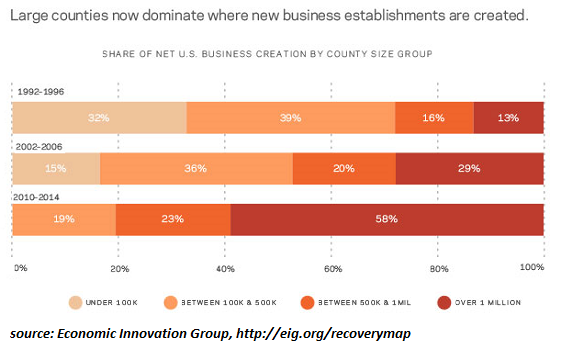Where Are the Jobs? Mostly In Big Cities
June 23, 2016
Maintaining the status quo of red tape, high taxes, high junk fees and indifference to small business realities guarantees decline and failure.
It's well known that millions of the jobs counted in employment statistics are part-time or low-paying "gig economy" self-employment. Over 9 million self-employed workers make less than $10,000 per year, and 5.5 million earn less than $5,000 per year. Granted, many of these workers may have other employment, but the point is millions of jobs that are puffing up official job totals are not full-time or even close to full-time.
Endangered Species: The Self-Employed Middle Class
Nonetheless, employment and new small businesses are expanding in some locales. According to this new study, The New Map of Economic Growth and Recovery (eig.org), growth in jobs and new business has become increasingly concentrated in a handful of high-population metropolitan counties.
In the high-growth early 1990s, half of all new businesses sprouted in 125 counties nationwide. In 2002-2006, the number of counties that were home to half of all new enterprises fell to 64. In the "recovery" years of 2010-2014, half of all new firms arose in a mere 20 counties nationally--an astonishing concentration.
We can see the asymmetry in this chart. Where counties with 1 million or more residents were home to 13% of new businesses in the 1990s, now 58% of business creation occurs in populous urban counties.

Here are the counties with the largest increases in employment (I'm listing only those with a 9% growth rate or higher).
1. Los Angeles CA 9.9%
2. Harris (Houston) TX 14.7%
3. New York NY 11.2%
4. Orange County CA 11.7%
5. Dallas TX 10.6%
6. Miami-Dade FL 14.7%
7.Santa Clara (San Jose) CA 13.7%
8. San Diego CA 9.2%
9. King (Seattle) WA 9.8%
10. Hennepin (Minneapolis) MN 11.4%
11. Tarrant (Dallas) TX 12.5%
12. San Francisco CA 16.8%
13. Oakland County (Detroit) MI 13.2%
14. Travis (Austin) TX 15.6%
15. Kings (Brooklyn) NY 15.0%
16. Orange County (Orlando) FL 11.7%
17. Hillsborough (Tampa) FL 13.9%
18. Mecklenburg (Charlotte) NC 13.2%
Not all of the jobs created in these urban centers are high-paying, of course. Some regions have more low-paying service jobs, and others have relatively more high-paying jobs.
Some of these locales have insanely high costs of living, which skews wage comparisons between regions.
Other than the welcome leap in jobs in Detroit, the big urban centers of growth are congregated on the Left and Right coasts and Texas (Minneapolis benefits from a concentration of corporate headquarters, universities and R&D--a mix that characterizes many of the job centers.)
The authors of the report reach some sobering conclusions about this geographic concentration of new businesses and new employment:
The geographically uneven nature of the decline in new business starts implies that large swathes of the country will soon contend with a missing generation of firms — ones that should be providing employment opportunities and new foundations for economic growth in the years ahead.
The uneven geography of new business formation tracks very closely with that of access to capital — particularly venture and other forms of risk capital. Addressing the former challenge will surely involve tackling the latter. Without mitigating these disparities, the trend towards increasing concentration documented here may even accelerate, given that today’s largest economic centers are the few remaining places producing tomorrow’s new businesses.
The new map of growth and recovery points to very different futures for American communities. These findings suggest that the gains from growth have and will continue to consolidate in the largest and most dynamic counties and leave other areas searching for their place in the emerging economic landscape.
The good news is that smaller cities have some advantages (much lower costs, for example) and they can generate meaningful, stable expansion of jobs and new businesses if they organize their efforts to maximize those advantages--and if they welcome new enterprises with an uncluttered, low-cost pathway to starting up.
There are a variety of messages buried in this data. One is: the more dynamic the business environment, the greater the opportunities to build networks, disrupt vested interests and find niches for small enterprises.
Cities that think luring one big corporation to locate a factory or office park in their area is the answer are deluded; that one big employer can decide to relocate or shut down operations in a heartbeat.
Maintaining the status quo of red tape, high taxes, high junk fees and indifference to small business realities guarantees decline and failure. The motto of the most dynamic elements of our economy is: trust the network, not the corporation or the state.
The local government can help by eliminating statutes and requirements that serve to protect sclerotic vested interests (forcing people such as florists to get absurdly unnecessary professional licenses, for example) or it can hinder it by looking on small business as tax donkeys who should be grateful for a chance to open a biz in town.
Guess what, folks--the tax donkeys can go elsewhere, to places where they are either welcomed or celebrated.
It's all about networks and network effects: this may sound high-tech, but it's just as true for a bakery as it is for a software company.
All About Network Effects (85-slide presentation)
The author of the recent book The Geography of Genius: A Search for the World's Most Creative Places from Ancient Athens to Silicon Valley concluded that creative places share three essential characteristics: disorder, diversity and discernment.
In other words, the exact opposite of places designed to preserve the privileges of
vested interests and a sclerotic status quo.
A Radically Beneficial World: Automation, Technology and Creating Jobs for All
is now available as an Audible audio book.
My new book is #11 on Kindle short reads -> politics and social science: Why Our Status Quo Failed and Is Beyond Reform ($3.95 Kindle ebook, $8.95 print edition) For more, please visit the book's website.
NOTE: Contributions/subscriptions are acknowledged in the order received. Your name and email remain confidential and will not be given to any other individual, company or agency.
|
Thank you, Donald C. ($50), for your magnificently generous contribution to this site-- I am greatly honored by your support and readership. |

Discover why I’m looking to retire in a SE Asia luxury resort for $1,200/month. |